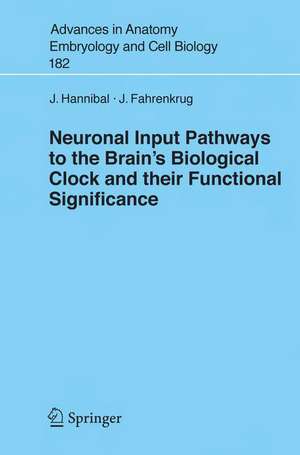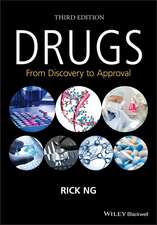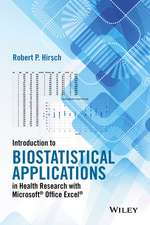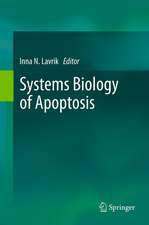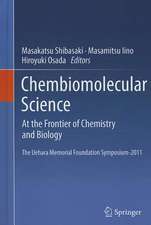Neuronal Input Pathways to the Brain's Biological Clock and their Functional Significance: Advances in Anatomy, Embryology and Cell Biology, cartea 182
Autor Jens Hannibal, J. Fahrenkrugen Limba Engleză Paperback – 12 dec 2005
Din seria Advances in Anatomy, Embryology and Cell Biology
- 5%
 Preț: 1146.33 lei
Preț: 1146.33 lei - 5%
 Preț: 721.19 lei
Preț: 721.19 lei - 15%
 Preț: 637.13 lei
Preț: 637.13 lei -
 Preț: 381.81 lei
Preț: 381.81 lei - 15%
 Preț: 644.95 lei
Preț: 644.95 lei - 5%
 Preț: 1025.16 lei
Preț: 1025.16 lei - 15%
 Preț: 689.97 lei
Preț: 689.97 lei - 15%
 Preț: 577.07 lei
Preț: 577.07 lei - 15%
 Preț: 580.36 lei
Preț: 580.36 lei - 5%
 Preț: 393.51 lei
Preț: 393.51 lei -
 Preț: 408.66 lei
Preț: 408.66 lei -
![Die Schlüpfdrüse der Geburtshelferkröte (Alytes o. obstetricans [LAURENTI]) und anderer Froschlurche](https://i4.books-express.ro/bs/9783662239742/die-schluepfdruese-der-geburtshelferkroete-alytes-o-obstetricans-laurenti-und-anderer-froschlurche.jpg) Preț: 408.27 lei
Preț: 408.27 lei - 5%
 Preț: 1090.61 lei
Preț: 1090.61 lei - 5%
 Preț: 705.11 lei
Preț: 705.11 lei - 5%
 Preț: 706.04 lei
Preț: 706.04 lei - 5%
 Preț: 357.61 lei
Preț: 357.61 lei - 5%
 Preț: 704.59 lei
Preț: 704.59 lei - 5%
 Preț: 705.11 lei
Preț: 705.11 lei - 5%
 Preț: 359.42 lei
Preț: 359.42 lei - 5%
 Preț: 711.52 lei
Preț: 711.52 lei - 15%
 Preț: 635.47 lei
Preț: 635.47 lei - 15%
 Preț: 631.72 lei
Preț: 631.72 lei - 15%
 Preț: 633.35 lei
Preț: 633.35 lei - 15%
 Preț: 632.37 lei
Preț: 632.37 lei - 5%
 Preț: 706.60 lei
Preț: 706.60 lei - 15%
 Preț: 631.07 lei
Preț: 631.07 lei - 5%
 Preț: 707.13 lei
Preț: 707.13 lei - 5%
 Preț: 707.33 lei
Preț: 707.33 lei - 5%
 Preț: 359.60 lei
Preț: 359.60 lei - 5%
 Preț: 707.69 lei
Preț: 707.69 lei - 5%
 Preț: 707.13 lei
Preț: 707.13 lei - 5%
 Preț: 708.06 lei
Preț: 708.06 lei - 5%
 Preț: 706.41 lei
Preț: 706.41 lei - 5%
 Preț: 708.78 lei
Preț: 708.78 lei - 5%
 Preț: 705.68 lei
Preț: 705.68 lei - 5%
 Preț: 705.11 lei
Preț: 705.11 lei - 5%
 Preț: 706.77 lei
Preț: 706.77 lei - 15%
 Preț: 635.15 lei
Preț: 635.15 lei - 15%
 Preț: 631.07 lei
Preț: 631.07 lei - 5%
 Preț: 706.77 lei
Preț: 706.77 lei - 5%
 Preț: 706.04 lei
Preț: 706.04 lei - 5%
 Preț: 710.79 lei
Preț: 710.79 lei - 5%
 Preț: 705.32 lei
Preț: 705.32 lei - 15%
 Preț: 633.19 lei
Preț: 633.19 lei - 15%
 Preț: 629.09 lei
Preț: 629.09 lei - 15%
 Preț: 633.53 lei
Preț: 633.53 lei - 15%
 Preț: 632.70 lei
Preț: 632.70 lei - 15%
 Preț: 633.68 lei
Preț: 633.68 lei - 18%
 Preț: 773.72 lei
Preț: 773.72 lei - 15%
 Preț: 630.43 lei
Preț: 630.43 lei
Preț: 704.39 lei
Preț vechi: 741.47 lei
-5% Nou
Puncte Express: 1057
Preț estimativ în valută:
134.78€ • 141.23$ • 111.42£
134.78€ • 141.23$ • 111.42£
Carte tipărită la comandă
Livrare economică 12-26 aprilie
Preluare comenzi: 021 569.72.76
Specificații
ISBN-13: 9783540277880
ISBN-10: 3540277889
Pagini: 88
Ilustrații: X, 76 p. 22 illus., 13 illus. in color.
Dimensiuni: 155 x 235 x 5 mm
Greutate: 0.14 kg
Ediția:2006
Editura: Springer Berlin, Heidelberg
Colecția Springer
Seria Advances in Anatomy, Embryology and Cell Biology
Locul publicării:Berlin, Heidelberg, Germany
ISBN-10: 3540277889
Pagini: 88
Ilustrații: X, 76 p. 22 illus., 13 illus. in color.
Dimensiuni: 155 x 235 x 5 mm
Greutate: 0.14 kg
Ediția:2006
Editura: Springer Berlin, Heidelberg
Colecția Springer
Seria Advances in Anatomy, Embryology and Cell Biology
Locul publicării:Berlin, Heidelberg, Germany
Public țintă
ResearchCuprins
Introduction.- The suprachiasmatic nucleus (SCN).- The endogenous rhythm of the SCN.- The SCN molecular clock.- Photic regulation of the circadian rhythm.- Retinal input – Neuroanatomy.- Neurotransmitters in the RHT.- Glutamate and PACAP.- Other neurotransmitters of the RHT.- RHT neurotransmitter receptors in the SCN.-Melanopsin - an irradiance detecting photopigment of the RHT.- Retinal input - Physiology.- Non-photic regulation of the circadian rhythms.- Midbrain raphe input - Neuroanatomy.- 5-HT and regulation of the circadian system.- The intergeniculate leaflet and the geniculohypothalamic tract – neuroanatomy.- Effects of NPY on circadian rhythm during subjective day.- NPY modulates light-induced phase shift during subjective night.- Summary.
Textul de pe ultima copertă
Circadian rhythms are entrained daily by environmental photic and non-photic cues. The present review describes the anatomy and functional characteristics of the three major input pathways to the circadian clock mediating entrainment, the retino-hypothalamic tract (RHT), the geniculo-hypothalamic tract (GHT) and the midbrain raphe projection.
Caracteristici
Includes supplementary material: sn.pub/extras
